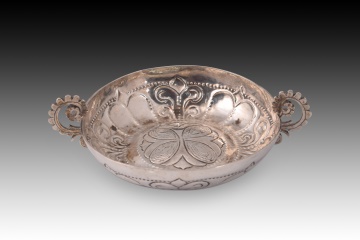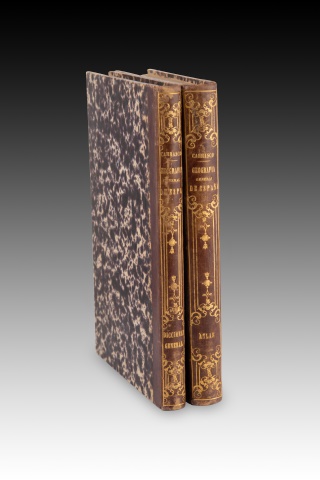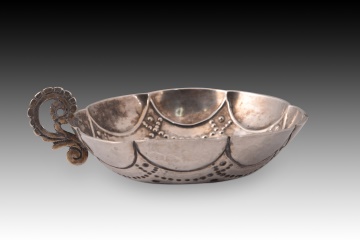
-

Quaking glass or wine-tasting glass. Silver. 18th century. Vessel known as a catavinos or tembladera (as it has no foot) made of silver in its colour with two flat handles in the shape of a “C” topped by volutes and decorated with wavy elements on the outside, which has a decoration on the edge (on the outside) of simple plant elements alternating with simple geometric elements made with lines and dots. On the bottom, on the inside, there is a plant element. In Spanish silverwork, the Baroque trends were maintained for almost the first two thirds of the 18th century, except in the capital, where Rococo forms were already introduced without displacing the previous ones. It was not until 1740 when French silversmiths introduced these novelties in Madrid, which would slowly spread to the rest of the centres, depending on the areas and masters. This survival of the forms of the 17th century can be seen in the fact that bernegales tembladeras were, in general, more common pieces in the 17th century, remaining during the 18th century relegated to centres far from the main areas of creation. Weight: 91 grams.
· Size: 14,5x11x3,5 cms
ANTIQUES
Ref.: ZE368
-
Sold

"
· Size: Long. 97 cms.
ANTIQUES
MISCELLANEOUS;OTHER OBJECTS
Ref.: Z5912
-
Three cross finials. Silver in its colour. 20th century, following 18th century models. Each of the three pieces features a winged angel's head as its central motif, surrounded and enhanced by an elaborate composition based on architectural motifs and plant elements, both with a strong classical influence. They are made of silver in their colour and do not have contrasting marks. Stylistically, they are inspired by Spanish models from the 18th century. Weight: 780 grams.
· Size: 10,5x3x12 cmsm (sujección 5x2 cms)
ANTIQUES
Ref.: Z6590
-
Pocket watch, Frères Esquivillon & De Choudens (ca. 1765-1830). Paris, France, 19th century. Pocket watch of the saboneta type with the exterior decorated in enamels (architectural composition with a certain exotic air) and white dial with Roman numerals for the hours and Arabic numerals every five for the minutes, and an inscription relating to its origin (which is referred to a series of engravings on machinery). “Frères Esquivillon & De Choudens” worked in Paris between about 1765 and 1830, creating highly valued pieces currently preserved in numerous private collections and in institutions such as the Metropolitan Museum in New York.
· Size: 6x1x6 cms.
ANTIQUES
Ref.: Z2298
-
Case with campaign cutlery and pocket knife. 19th century. A cylindrical case with a hinged closure that contains various field cutlery, such as a spoon, a knife, a removable fork, etc. secured in a rigid case and stored in a metal container. This type of travel item was widely used during the 19th century.
· Size: 8x8x16 cms.
ANTIQUES
MISCELLANEOUS;OTHER OBJECTS
Ref.: Z3806
-
Pair of frames. Wood. 20th century. Pair of carved wooden frames decorated on the front with a composition of mouldings of different widths, all smooth, combining straight and curved shapes.
· Size: 152x7x172 cms.
ANTIQUES
Ref.: Z3959
-
Silver Bernegal. Portugal, 19th century. With contrasting marks on the base. Bernegal with wavy edges, rocaille decoration and plant elements on the outside and two “S” shaped handles. The flower that decorates the base on which this vessel rests can be found with the hallmarks, which date and situate the work in Portugal, in the 19th century, a time when it was very common to be inspired by styles of the past (Baroque, in this case). Weight: 170 gr.
· Size: 18,5x15x7 cms.
ANTIQUES
MISCELLANEOUS;SILVER WORKS
Ref.: Z4961
-
Renaissance bronze bell, 1555. Dated. Stem decorated with plant elements, with shoulders decorated with elegant lines, the middle has profiles within plant garlands and two legends above and below in Latin. Bells were already used by Catholics to call the faithful from the 5th century, but their use in civil matters and in other religions is known to have been in Greek and Roman times. The decoration of this bell, made in relief, places it in the Renaissance due to its inspiration in Roman coins for the profiles and plant elements it presents. Likewise, the date of the body places the creation of the piece with certainty, in addition to adding value to it. The inscriptions prove its religious use.
· Size: 7x7x11,5 cms.
ANTIQUES
MISCELLANEOUS;OTHER OBJECTS
Ref.: Z6213
-
Salvilla. Silver. Edward, John & William Barnard. England, London, 1862. With contrast marks. Round salver with mixed linear contours decorated with elements in light relief towards the edge and engravings towards the centre, arranged around initials, and raised on legs with vegetal and architectural elements combining a polished finish with another. Edward Barnad & Sons was a company that was founded in London around 1860 by Anthony Nelme. Edward Barnad (died 1855) became the owner in 1829, trading as Edward Barnad & Sons, together with his sons Edward (died 1868), John and William (died 1851). Weight: 750 gr.
· Size: 30x30x3,5 cms.
ANTIQUES
Ref.: ZF0721
-
Pair of forged iron fork locks. 17th century. Pair of forged iron fasteners of the so-called “fork” type due to their shape. This type of piece was used in furniture to secure tables, both dining tables and desks, and for this reason it is a very common piece of forged iron. The spirals and the balustrade parts date both to the Baroque period.
· Size: 93x30 cms.
ANTIQUES
MISCELLANEOUS;OTHER OBJECTS
Ref.: Z5447
-
Silver naveta. Spain, 17th century. A forged vessel with the base and lid finials obtained by mould casting. Shaped like a symmetrical boat, it stands on a low circular base with a disc-shaped base and a short shaft with a central lens. The body is decorated by chiselling, with oval cartouches flanked by braces and crowned by rhombuses and half-moons, located on the four axes and on a dotted shaded background that extends outlining the mouth. The lid has the same chiseled motif. At the stern end there is a finial in the form of an acanthus leaf, in relief, and at the bow end there is a handle in the form of a banded pillar. The bow lid is openable thanks to a central hinge. The piece has partial punch marks on the lid and body.
· Size: 18,5x9x8,5 cms.
ANTIQUES
Ref.: ZF1253
-

Two volumes: Geographical Atlas of Spain (…) and General Dictionary of all Peoples. Editors Gaspar y Roig. Spain, Madrid, 1864 and 1862. Two volumes framed in a similar way, with leather spines and gold elements. Here a reference to each work (lower area) and the name Carrasco (upper part) appear clearly. One of the volumes is the Geographical Atlas of Spain. Adjacent Islands and Spanish Overseas Possessions. It is indicated that it belongs to the “Collection of maps engraved in steel constructed by Don Martín Ferreiro”, and that it was published in Madrid by the Printing and Bookshop of Gaspar y Roig (the editors), in 1864. It presents a series of maps, engraved in steel (see the touches of color), constructed by Martín Ferreiro and Peralta (1830-1896) and engraved by R. Alabern (indicated under the images). The other volume is the General Geography of Spain. General dictionary of all peoples., belonging to the so-called Illustrated Library of Gaspar and Roig. Published in Madrid, by the Printing and Bookshop of Gaspar and Roig (editors), in 1862.
· Size: 18x5x27 cms.
ANTIQUES
Ref.: ZF1298
-
Vase. Glass. Following models by Émile Gallé (Nancy, 1846-1904). Vase made of glass, with white, brown and gold tones, following both in technique and decoration the well-known Art Nouveau works of Émille Gallé, an artist internationally recognized both for his aesthetics and for his technical advances with glass ("enamel", "cameo", etc.).
· Size: 15x15x28 cms.
ANTIQUES
MISCELLANEOUS;CERAMIC
Ref.: Z5671
-
Talavera inkwell, 18th century. Glazed ceramic. Talavera ceramic inkwell, decorated with cobalt blue enamel on a white tin slip With restorations
· Size: 16x16x7 cms.
ANTIQUES
MISCELLANEOUS;CERAMIC
Ref.: Z5695
-
Devotional pendant in gold and enamel, Mary Magdalene and Saint John the Baptist, 18th century. Possibly Mallorcan. One of the windows is broken. Oval pendant decorated around its edges with turned gold bows and small metallic pearls. One of its fronts shows Mary Magdalene, as a hermit, with a skull, a cross and a book; the other presents the image of Saint John the Baptist, accompanied by a cross and a lamb, alluding to the Gospel text. These types of pieces were highly valued by their owners as elements of devotion, and could also, at the same time, contain a relic inside.
· Size: 4.5x0,5x4 cms.
ANTIQUES
MISCELLANEOUS;OTHER OBJECTS
Ref.: Z6451
-
almatoria. Silver. Francesc P. Arquer, Barcelona, around 1825. With hallmarks and engraving marks. Silver candlestick in its colour with a raised bowl on two small legs and a flat handle (curved towards the end, area where the third leg is located), decorated with a series of plant elements and details common in Neoclassicism in light relief (string (of pearls, etc.). The piece has some engraving marks and other hallmarks. The latter link the piece to Barcelona silverwork, placing it in the workshop of Francesc Arquer, and in the 19th century. Weight: 158 grams.
· Size: 29x9x7 cms.
ANTIQUES
MISCELLANEOUS;SILVER WORKS
Ref.: Z6732
-
Candlestick with chain. Silver. Francesc. P. Arquer, Barcelona, Spain, circa 1825. With hallmarks, engraving and ownership marks (AS). Silver candlestick in its colour with an openwork bowl on two levels and raised on two small legs (inside which there is a vase-shaped piece to hold the candle and a braided decoration towards the centre), and a flat handle (curved towards the end, area where the third leg is located), decorated with a series of simple openwork shapes and fine strings of small pearls on the edges of the handle and the bowl. The piece has some engraving marks, others of ownership under the bowl (AS) and others of hallmark. The latter link the piece with Barcelona silverwork, placing it in the workshop of Francesc Arquer, and in the 19th century. Weight: 183 grams.
· Size: 28,9,5x5,5 cms.
ANTIQUES
MISCELLANEOUS;SILVER WORKS
Ref.: Z6733
-
Candlestick with chain and clips. Silver. F. Roca, Barcelona, around the first half of the 19th century. With hallmarks and engraving marks. Silver candlestick in its colour with an openwork bowl raised on two small legs (inside there is a vase-shaped piece to hold the candle) and a flat handle (curved towards the end, area where the third leg is located), decorated with two bands of pearls on the sides (a motif that also appears on the edge of the bowl) and from the end of which emerges a chain that ends in some tweezers (which are placed on a piece soldered to the bottom of the handle). The piece has two engraving marks and other hallmarks under the bowl. The latter place the work in Barcelona, by F. Roca, a silversmith active in the city during the second half of the 18th century and the beginning of the 19th century. Weight: 185 grams.
· Size: 23,5 x 8,5 x 7 cms.
ANTIQUES
MISCELLANEOUS;SILVER WORKS
Ref.: Z6734
-

Box or casket with royal monogram. Mahogany wood, metal. Spain, 19th century. It has slight damage. Rectangular box with a flat lid and a keyhole on the front, decorated with metal applications on the corners, edges, handles, etc. Below the keyhole there is a fleur-de-lis. The lid has a central motif with fleur-de-lis and a crowned M, and alternating crowned castles and lions in the corners. This emblem (and the fact that it is accompanied by lions and castles, alluding to Castilian heraldry) is reminiscent of the royal monograms that all members of the royal family apparently had in the past to mark their belongings. In this case, it is possible that it refers to Maria Cristina of Bourbon-Two Sicilies (Palermo, 1806-Sainte-Adresse, 1878), wife of Ferdinand VII and regent during the minority of Isabel II. However, we must remember Maria Cristina of Habsburg-Lorraine or of Austria (1858-1929), wife of Alfonso XII. The emblem of Maria de las Mercedes de Orleans and Bourbon (Madrid, 1860-1878), wife of Alfonso XII, used to appear with two capital “Ms”.
· Size: 78x31x24 cms.
ANTIQUES
Ref.: ZF1170
-
18th century ponderal weight. Bronze. Incomplete bronze ponderal, with the container vessel and two of the smaller ones, all cold decorated with incised and stamped motifs, simple edges on the small vessels and more complex borders on the container vessel. Nested cup weights are a set of cup-shaped weights that fit precisely inside each other. A complete set is one that retains all its original cups. The largest, called the keeper, consists of an upper lid with a handle and a closure, and weighs exactly the same as the sum of all the others. The second in descending order weighs half as much as the keeper, and the same as the sum of the rest. This proportionality is maintained until the last weight, called the disk or last piece, which is usually solid and closes the set. This principle remained unchanged until the introduction of the decimal metric system.
· Size: 11x12x12 cms.
ANTIQUES
MISCELLANEOUS;OTHER OBJECTS
Ref.: Z3034
-
Frame. Carved wood. 17th century. It has faults. Rectangular frame made of carved wood that still retains part of its original polychromy. As was usual in various European schools since the Renaissance (particularly the Italian one, but also the Spanish one, for example), it is decorated with a series of smooth mouldings of different widths, arranged leaving a smooth strip.
· Size: Ext 175x95 cm Int: 1.55x74 cms.
ANTIQUES
Ref.: Z6224
-

Quaking glass or wine-tasting glass. Silver. 18th century. One handle is missing. A vessel known as a catavinos or tembladera (as it has no foot) made of silver in its colour with a flat handle curved in the shape of an “S” decorated with simplified plant elements, and a line of mortise-shaped pieces (gallon-shaped shapes) on the edge enhanced by a smooth band. Towards the inside it has strings of pearls and dots, and a cross on the bottom. Bernegales and mortise-shaped pieces were frequent in Spanish silverware in the 17th century, usually being relegated to centres of somewhat less importance in the 18th century. Compare with pieces such as the silver bernegal from the last third of the 17th century in the Lázaro Galdiano Museum (perhaps from the Portuguese school; inventory 3916), or the one dated between 1640 and 1665 from the same museum (inventory 3910), or the one by José Jiménez de Illescas (inventory 3915, dated 1715-1725) in the same institution. Weight: 101 grams.
· Size: 12x10x4 cms.
ANTIQUES
Ref.: ZE367
-
Silver spice rack. Stefano Olivero, Italy. Possibly 19th century. Silver spice rack raised on simple legs, located at the chamfered ends of the piece, decorated on the outside with garlands and other architectural elements of classicist influence in light relief. Weight: 198 grams.
· Size: 5,5 x 8,5 x 6,5 cm
ANTIQUES
Ref.: ZF0006
-
Peace-bearer. Bronze. 16th century. Bronze peace-holder with an asymmetrical “S” handle on the back, which features a slightly raised decoration on the front framed in an architectural composition decorated with elements of classical influence (a scallop shell at the top, plant elements in the upper area, columns with decorated shafts, architrave, base with semicircular arches, etc.), which has a heraldic shield in the centre of the lower area. Under a winged angel's head, the central theme of the peace-holder is presented: Lamentation over the body of the dead Christ, with the cross in the background, Mary with Christ, flanked by two figures. The heraldic shield is very similar to that of the House of Mendoza used by Íñigo López de Mendoza y de la Vega, 1st Marquis of Santillana, and progenitor and head of the Ducal House of Infantado (which also features it).
· Size: 7,5x4x12 cms.
ANTIQUES
MISCELLANEOUS;OTHER OBJECTS
Ref.: ZF0541A